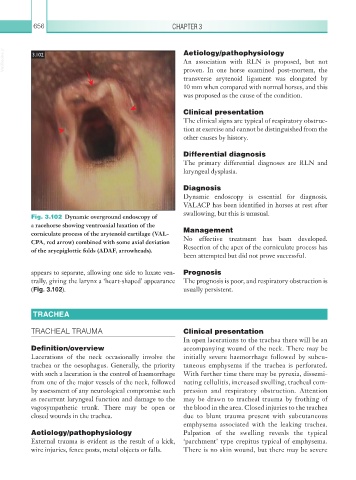Page 681 - Equine Clinical Medicine, Surgery and Reproduction, 2nd Edition
P. 681
656 CHAPTER 3
VetBooks.ir 3.102 Aetiology/pathophysiology
An association with RLN is proposed, but not
proven. In one horse examined post-mortem, the
transverse arytenoid ligament was elongated by
10 mm when compared with normal horses, and this
was proposed as the cause of the condition.
Clinical presentation
The clinical signs are typical of respiratory obstruc-
tion at exercise and cannot be distinguished from the
other causes by history.
Differential diagnosis
The primary differential diagnoses are RLN and
laryngeal dysplasia.
Diagnosis
Dynamic endoscopy is essential for diagnosis.
VALACP has been identified in horses at rest after
swallowing, but this is unusual.
Fig. 3.102 Dynamic overground endoscopy of
a racehorse showing ventroaxial luxation of the
corniculate process of the arytenoid cartilage (VAL- Management
CPA, red arrow) combined with some axial deviation No effective treatment has been developed.
of the aryepiglottic folds (ADAF, arrowheads). Resection of the apex of the corniculate process has
been attempted but did not prove successful.
appears to separate, allowing one side to luxate ven- Prognosis
trally, giving the larynx a ‘heart-shaped’ appearance The prognosis is poor, and respiratory obstruction is
(Fig. 3.102). usually persistent.
TRACHEA
TRACHEAL TRAUMA Clinical presentation
In open lacerations to the trachea there will be an
Definition/overview accompanying wound of the neck. There may be
Lacerations of the neck occasionally involve the initially severe haemorrhage followed by subcu-
trachea or the oesophagus. Generally, the priority taneous emphysema if the trachea is perforated.
with such a laceration is the control of haemorrhage With further time there may be pyrexia, dissemi-
from one of the major vessels of the neck, followed nating cellulitis, increased swelling, tracheal com-
by assessment of any neurological compromise such pression and respiratory obstruction. Attention
as recurrent laryngeal function and damage to the may be drawn to tracheal trauma by frothing of
vagosympathetic trunk. There may be open or the blood in the area. Closed injuries to the trachea
closed wounds in the trachea. due to blunt trauma present with subcutaneous
emphysema associated with the leaking trachea.
Aetiology/pathophysiology Palpation of the swelling reveals the typical
External trauma is evident as the result of a kick, ‘parchment’ type crepitus typical of emphysema.
wire injuries, fence posts, metal objects or falls. There is no skin wound, but there may be severe

